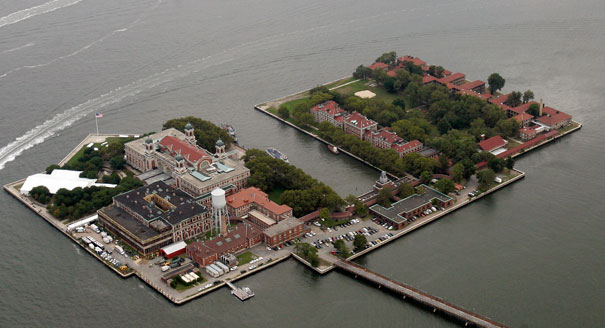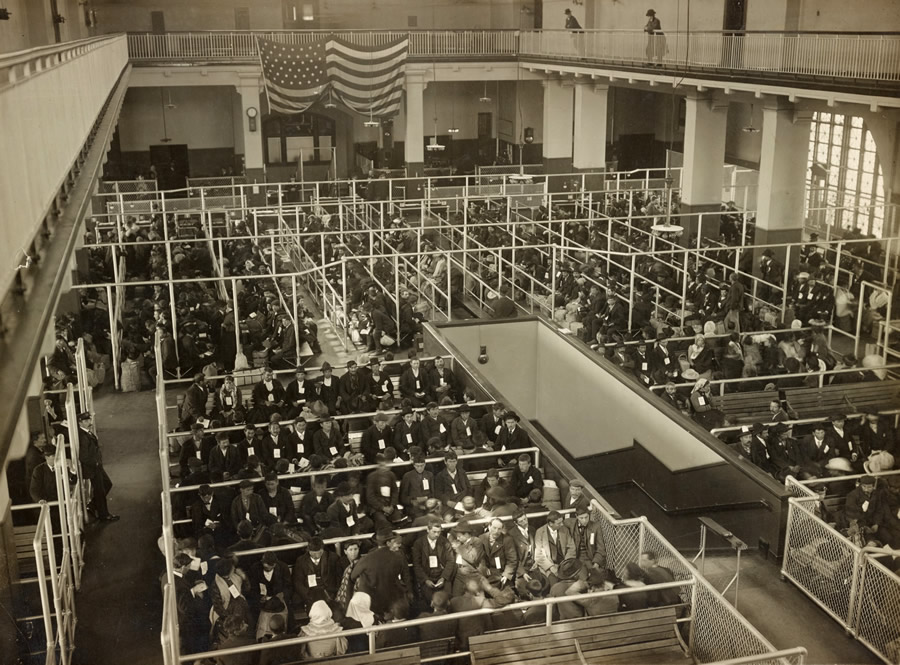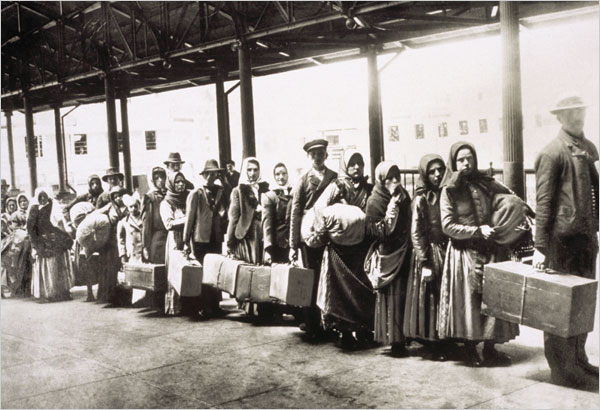 |
| Ellis Island |
Ellis Island was the chief port through which immigrants came to the United States from 1892 to 1954. Located at the mouth of the Hudson River in New York Harbor, Ellis Island witnessed the arrival of more than 12 million immigrants into the United States, most of whom were European. Of the millions who came through Ellis Island, nearly 2 percent were denied entrance to the United States for one reason or another.
Immigrants coming into the United States were classified according to the manner in which they arrived. Those who came in first and second-class accomodations were presumed to be of good enough social standing that they would not prove to be a burden on American society. First and second-class passengers came to Ellis Island only if they had particular legal or medical problems that could deny them entry into the country.
Third-class, or steerage, passengers were not so lucky. The accomodations of their crossing were substandard, located on the bottom of the ship, often in cramped quarters near the ship's supplies. The conditions in steerage were often unsanitary, crowded, and uncomfortable.
  |
Unaccompanied women were often in danger of sexual assualt from the other passengers. The trials of third-class passage did not stop with the arrival of the ship to the United States. Because of the low cost of their passage, steerage passengers carried the risk of becoming a financial burden to the country.
Hence, steerage passengers were sent to Ellis Island to gain entry. On Ellis Island these immigrants underwent legal and medical inspections that could last as long as five hours. Immigrants with debilitating medical conditions or significant legal problems were denied entrance.
These inspections were performed by the U.S. Public Health Service and the Bureau of Immigration, who referred to manifest logs from the ships at the time of the inspection. These manifests included personal information about the passengers such as name, date of birth, country of origin, current amount of available funds, and an address to which the person was traveling—generally that of a relative.
 |
| The pens at Ellis Island, Main Hall. These people have passed the first mental inspection. (1902-1913). |
All passengers needed a destination and could be denied entrance if they did not have a specific place to which they were going. Examiners asked questions that were used to determine the general health of immigrants, to detect chronic disease and mental health concerns, and to highlight legal problems.
Those who did not possess the basic skills to work or had chronically poor health were sent back to their country of origin. Others were quarantined to prevent the spread of infectious disease. More than 3,000 immigrants died in the hospital on the island.
Once through the inspection, many of the new immigrants changed their names. Sometimes this was strictly for convenience, but often it was because both the immigrants and inspectors tended to be uneducated. Names were often spelled incorrectly, made more American, shortened, or spelled phonetically.
   |
Frequently, passengers came to Ellis Island without papers. These passengers, called "WOPs" by the examiners, were generally allowed to enter the country. Passengers traveling without papers tended to be Italian, and the term WOP quickly became an epithet for all Italian immigrants.
While the immigration process was long and often frustrating, many underwent the process multiple times. Men frequently traveled back and forth between Europe and the United States as seasonal workers. Because of this, the immigration figures from Ellis Island are skewed. At the time there was no technology to accurately count people as repeat immigrants.
In 1897 a fire destroyed many of the Ellis Island facilities, causing them to close for a substantial renovation. During this time the Barge Office in Battery Park served as a temporary immigration station until the Ellis Island facilities could be reopened on December 17, 1900.
 |
| Passages Immigrants at Ellis Island awaiting a ferry to the city |
After the renovation the processing of immigrants became more efficient. The facility expanded by 10 acres, and the island was capable of processing thousands of immigrants per day at a much faster pace than had been previously possible.
Additionally, the facilities expanded to encompass a nearby island that included an administration building and hospital wards; 10 years later, a third island was added, housing additional hospitals for use as quarantine zones.
Throughout much of its history, corruption was one of Ellis Island's biggest problems. In 1901 President Theodore Roosevelt fired several high-ranking officials including the commissioner of immigration and the head of the Bureau of Immigration.
Investigation found frequent instances of immigrants being pressured into bribing inspectors, with many being detained if the immigrants questioned the need for the bribe or did not (or were not able to) produce the money.
Attractive young women, having survived the passage in steerage, were forced to grant sexual favors to inspectors to guarantee admittance to the country. Inspectors sold items such as lunches and railroad tickets at exhorbitant prices, forcing the new immigrants to pay, with the officials and inspectors taking the additional revenue for themselves.
Workers frequently lied about the exchange rate, pocketing the extra money, while other inspectors sold fake immigration citizenship certificates, giving a cut of the proceeds to ship officers. To Roosevelt's mind such corruption could not stand and needed to be stopped.
Roosevelt appointed William Williams, a New York lawyer, as commissioner in April 1902. Williams created an environment in which the immigrants were treated with respect, consideration, and kindness. Signs were posted throughout the island promoting kindness and respect and serving as a constant reminder to workers on how to conduct themselves. Williams's duty was to undo the damage caused by corruption.
Many European immigrants came to the United States during World War I, but passage was eventually prohibited. Many immigrants stayed on Ellis Island because they could not be sent back to their home countries, and the island served as a confinement center for 1,500 German sailors and 2,200 secret agents and foreigners.
Travel by ship was hazardous because of the frequency of submarine attacks, and many European nations shut down their borders. Additionally, the navy took over the island's large hospital during the war in order to care for injured naval soldiers and sailors.
As a result, from 1918 to 1919 many immigrants and suspected subversives were taken off the island and sent elsewhere. During the Red Scare immigrants suspected of involvement with radical organizations or under suspicion of fomenting revolution were deported from Ellis Island.
Such views were enhanced by the sabotage inflicted on Ellis Island on July 30, 1916. The Black Tom Wharf on the New Jersey shore was located about 300 yards from Ellis Island. Here there was a railroad yard and a place for barges to load cargo. On July 30 several railroad cars and as many as 14 barges were loaded with dynamite, ready to have their cargoes transferred to waiting freighters.
The cargoes exploded early that morning, causing extensive damage to Ellis Island and creating a blast that was felt as far away as Pennsylvania. The damage to Ellis Island was estimated at $400,000—broken windows, jammed doors, and demolished roofs. During the chaos 125 workers transferred nearly 500 immigrants to the eastern part of the island and ferried them over to the Manhattan Barge Office. Ellis Island reopened in 1920.
Throughout the history of Ellis Island, laws and regulations were enacted to decrease the number of immigrants entering the United states. For instance, the Immigration Restriction League and other similar organizations created the Exclusion Act of 1882, prohibiting Chinese immigration for 10 years.
This act continued to be reassessed and passed until 1943. In 1917 the Alien Contract Labor Law came into effect, further reducing immigration, while mandatory literacy tests in the same year allowed for the exclusion of more and more potential immigrants.
While these acts did limit the number of new people entering the United States, more than half a million passed through Ellis Island in 1921 alone. In 1924 quota laws and the National Origins Act were passed through Congress; these laws allowed for limited numbers of specific ethnic groups to be given entry into the country as determined by the 1890 and 1910 censuses.
Some 33 different classes of immigrants to be denied entrance were named in the legislation. In effect, the laws differentiated between northern European settlers and what were at the time immigrants from predominantly southern and eastern European countries.
Adding an additional layer of bureaucracy for potential immigrants, following World War I it became necessary to apply for visas in one's home country before being allowed to enter the United States. This increased the complexity of the immigration process, as it required a great deal of paperwork and medical inspection before arrival to the United States.
Following 1924 Ellis Island stayed in use, but as more of a quarantine and detention center than a center for the processing of immigrants. Those who stayed on Ellis Island tended to be those with complications in their medical records or those who had been displaced.
Immigrants in general entered the United States through other locations. Proposals were made as early as 1924 to close down the island, but this did not occur until 1954. Before that, Ellis Island was used as a place to confine enemy foreign nationals during World War II.
In 1986 the island underwent a significant restoration to the main building, and Ellis Island reopened in 1990 as a museum. Here visitors can access the records of family members who came to or passed through Ellis Island during its tenure as the largest entry point for immigrants into the United States.